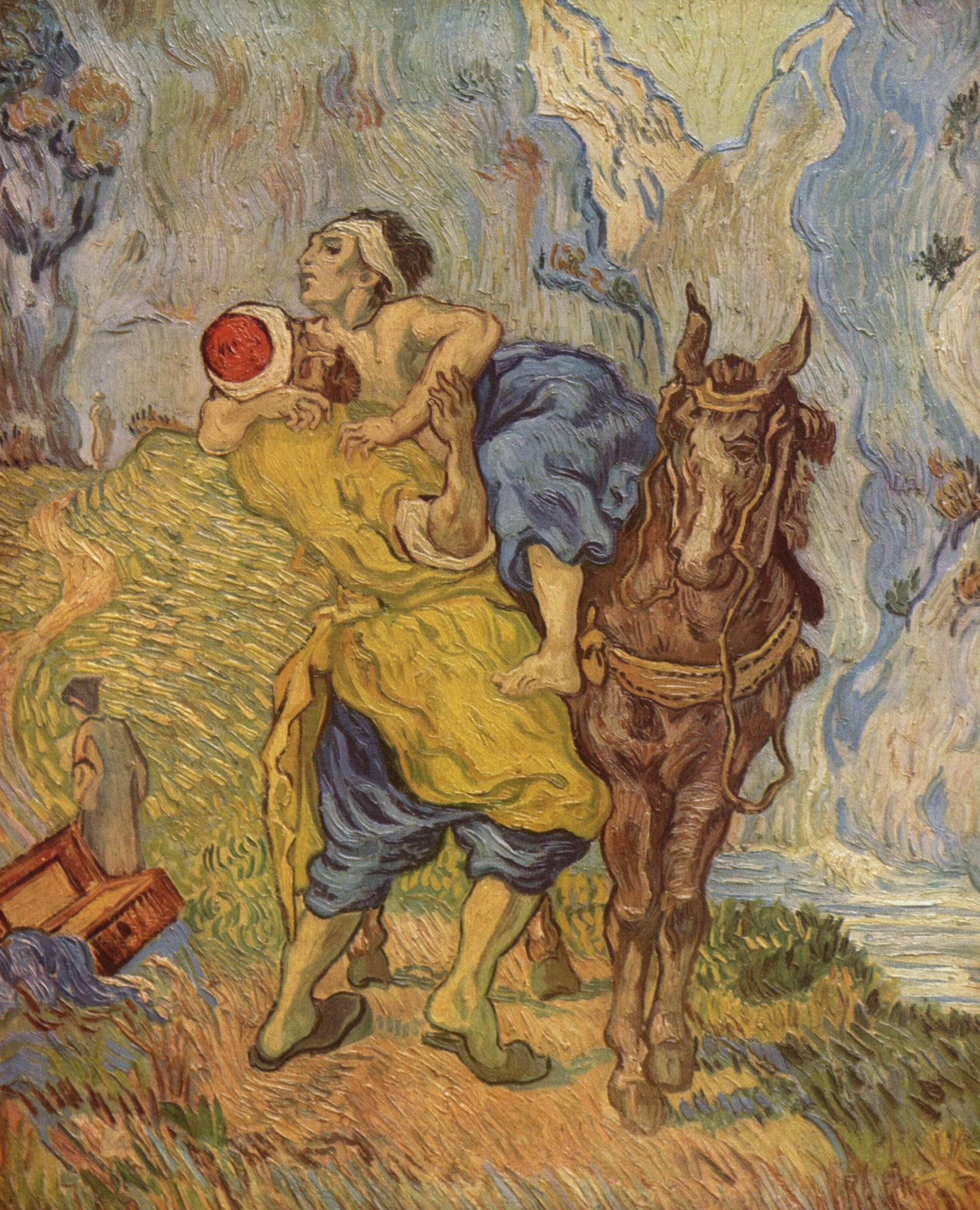Rescuing a parable from domestication and banality
Stephen Adam, 14 July 2019
Colossians 1: 1–14; Luke 10: 25–37
A couple of years ago my wife and I were fortunate enough to have a holiday in the deep south of France in St-Rémy-de-Provence, not far from Avignon. We visited the asylum there where Vincent van Gogh was a patient only months before taking his own life. Due to his own psychological and social struggles he knew only too well what it was like to be left bleeding by the side of the road. He had cut off his ear and was known as ‘the red-headed madman’ by the people in his own community.
It was during this season that he painted his version of the Good Samaritan, picturing himself as the traveller in need. As an artist he had spent his entire life being passed by and overlooked. We could imagine him sitting in his room in the asylum, the fields of lavender outside, while within the tall corridors echoed with the tormented cries of his fellow patients. It’s a lonely picture.
Van Gogh presents the Samaritan as the person of Christ. He is the one picking us up in our broken condition, he is the one freeing us from ugliness and mockery. Today we see the parable primarily in moral terms – who is my neighbour, what is my responsibility to others? Does charity begin at home?
But van Gogh’s portrait is a reminder that there has been a long theological tradition of interpreting the parable at a more profound level, seeing in the narrative nothing less than the story of our redemption by Christ: the wounded man on the road representing the plight of humanity; the priest and Levite representing the law and prophets of the Old Covenant, who can do nothing; and then the Good Samaritan – Christ – coming to the rescue with his redemptive, saving love.
At a profound level, the wounded man represents the plight of humanity … and the Good Samaritan Christ, coming to the rescue with his redemptive, saving love.
Today the parable, so familiar to us, has lost its force and been domesticated to the point of being banal. One thinks of it as a ‘nice story’ and Samaritans as ‘nice people’. There are any number of hospitals named the Good Samaritan; if you need help you pick up the telephone to the Samaritans. (Rowan Williams recounts how when he spoke to a group of very young children about the parable, one of them asked whether they had phones in biblical times!)
The language has been hijacked into everyday secular and political parlance – Margaret Thatcher famously arguing that it was wealth-creation that would enable us to be good Samaritans with the resources allowing us to act on ethical principles, while on the political left the state and government is often presented as the Good Samaritan, the agency that has the responsibility to intervene decisively and will not pass by on the other side.
Today even the language of ‘neighbour’ has lost much of its force. We think of our neighbour as the person next door – though even there relations can be difficult! There’s a website problemneighbours.co.uk which identifies noise, boundary issues, trees, hedges and anti-social behaviour as the main problems. But Jesus’ response to the young lawyer’s question ‘Who is my neighbour?’ transcends all that and is deeply challenging. It would have been so much easier, and saved so many sermons over the generations, if Jesus had simply replied ‘Everyone’ and left it at that.
But no, we have to put ourselves in the position of the Jewish hearers of his time, who would have found his answer deeply shocking and offensive. For in Jesus’ telling the neighbour is not the decent, friendly person next door, the person you can rely on, but the hated outsider – one of the Samaritans, who were regarded by Jews as heretics, traitors and sworn enemies.
The Samaritan’s example cuts across ethnic divides, across centuries of separated history, across all the things that had kept Jew and Samaritan apart. The parable challenges us today to reflect on all that divides our society – whether it be ethnicity, religion, class, politics, sexuality – and calls us to reflect on how we can bridge that divide.
Often when we discuss the parable the priest and Levite come out of it pretty badly. They’re presented as hypocrites, with their concern for ritual purity and personal safety leading them to pass by on the other side. But is that entirely fair? Was the priest’s problem not so much that he was hypocritical, but that he was religious to the nth degree – he was following absolutely correctly and dutifully the requirements of a particular law, no doubt mindful of the prescription that anyone who touched a dead body was unclean for seven days (Numbers 19: 11).
He could not be sure, but he feared the man was dead; to touch him would mean losing his turn of duty in the Temple, and he refused to risk that. He was putting the strict demands of his understanding of the law above that of mercy and compassion. It was the outsider, the hated alien, who had to reveal the right response in the circumstances, to put aside the strictures of a particular religious text – to put aside the letter of the law for the spirit of the law.
Does this speak to us, as individual Christians or as the Church as an institution, today? One of the points of the story is not so much that ‘we’ should be nice to ‘them’, but rather that we – the insiders, if you like – need to have the humility to recognise that we are likely to have to depend in important ways on the apparently alien and threatening stranger to enlarge our understanding of what it is to be truly human, and what love of neighbour really means. We need to recognise that we haven’t got it all sorted, we don’t have all the answers and we may get it wrong.
We need to have the humility to recognise that we are likely to have to depend in important ways on the apparently alien and threatening stranger to enlarge our understanding of what it is to be truly human.
In writing about the relationship between the Church and the world the French theologian Yves Congar wrote that they are not to be imagined ‘like two crowned sovereigns looking sideways at one another as they sit on the same dais’, but ‘much more like the Good Samaritan holding in his arms the half-dead man, who he will not leave because he has been sent to help him’. Yes, this analogy draws attention to the importance of the Church’s mission, and how throughout history the Church has been a source of support and consolation to suffering people, whatever their faith.
But that analogy on its own can also lead us to be too narrow, too focused on the Church being the star of the show. The truth is that there is wisdom in the world beyond the Church, wisdom that we need to have the humility to learn from.
There’s a danger that we identify ourselves too readily with being the Good Samaritan and forget the disquieting context in which the parable is set. The priest and Levite are too busy about the ‘things of God’ to pay heed to the cries of the victim, and it is the outsider, the outcast from the covenant community, who provides the example to be imitated.
There are some churches and Christian communities which are closed and inward-looking, absolutely secure in their teaching, in their received interpretations, as if not wanting to risk contact with those not of the same view. A contrast to our own strapline, ‘We are pilgrims on a journey – come and join us!’ and us striving to be a church with ‘soft edges’, as Peter Seal often puts it. But as Rowan Williams once wrote, we have to go out into the world ‘to witness to the gospel’s capacity for being at home in more than one cultural environment, and to display enough confidence to believe that this gospel can be rediscovered at the end of a long and exotic detour through strange idioms and structures of thought’.
When we enter into dialogue with the world that is not the Church, we can see this as an act of confidence in the robustness of the fundamentals of our faith and that we can then be open to learning from the insights of other cultures, other traditions, and other faiths – and from those of no faith. How far are we open to the possibility of worldly wisdom leading us to modify some of our traditional positions on what makes for true human flourishing?
Jesus’ parables are rarely straightforward stories. It’s more like a question-and-answer session, a drama, a dialogue where Jesus says, ‘Who are you in this story? Where are you going to put yourself in all this?’
Where are we this morning? Do we identify with Jesus’ instruction, ‘Go and do likewise’, to show that there no boundaries to love of neighbour? Do we identify with the priest, with our questions and excuses for limiting our compassion or putting off our actions? Or do we identify most deeply, as van Gogh did, with the traveller, the one with wounds and scars and in need of divine love? Or do we identify a bit with each of these characters?

